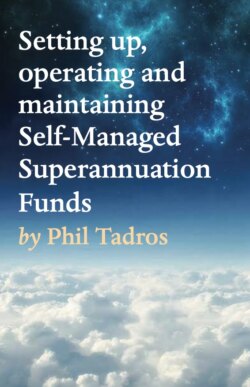Читать книгу Setting up, operating and maintaining Self-Managed Superannuation Funds - Phil Tadros - Страница 1
ОглавлениеChapter 1 - Introduction
Superannuation is like a savings account used to put money aside for taxpayers (individual people) until they reach retirement or preservation age. The superannuation money is usually paid by an employer towards a nominated superannuation fund of the employee, and this amount is set at 9.5% of the total gross earnings of the employee. The ever growing Self-Managed Superannuation Fund (SMSF) industry in Australia is a way for individuals to have more control over their retirement money in terms of investing in different assets, or different classes of assets, which other industry superannuation funds are less likely to invest in, or have a direct investment in.
There are two different authorities that govern superannuation in Australia. The body that oversees the large industry superannuation funds, such as HESTA, Host Plus, CBUS, is the Australian Prudential Regulation Authority (APRA). The body that governs, or oversees the SMSFs is the Australian Taxation Office (ATO).
The COVID-19 pandemic has led to some changes in superannuation, and these changes will not be discussed at length in this book, because the ATO website has information that is up to date.
So what is an SMSF? Dixon Advisory defines an SMSF as “a superannuation trust structure that provides benefits to its members upon retirement. The main difference between SMSFs and other super funds is that SMSF members are also the trustees of the fund. SMSFs can have between one and four members, and one of the main advantages is the level of control that trustees have when it comes to tailoring the fund to meet their individual needs”.
Why do more and more people choose to set up and operate a SMSF? One of the reasons is that they like to be in control of where their investment money is going, and be able to have a direct investment in particular types of assets. Another reason may be that a person is running a business, and wants to have the SMSF own that business property, so that the person can pay rent to the SMSF and at the same time benefit from the income, especially if the person is at retirement or preservation age.
There are advantages and disadvantages in setting up and maintaining a SMSF, and in order to consider whether this is for you, the advantages must be greater than the disadvantages. There are also taxation concessions and implications in having a SMSF. The tax concessions are that the SMSF is taxed at 15% of its taxable income (assessable income minus deductions), and taxed at 1/3 (or 10%) of any capital gains that the SMSF derives. However, there are tax implications if a breach of the superannuation rules occur, possible fines and penalties, non-compliance status and the SMSF will be taxed at 45% of its income and assets. That is very hefty. However, your accountant or tax agent will guide you to ensure you do not breach, or continue to breach, the superannuation provisions in your SMSF.
Some advantages of having a SMSF are:
you can have up to four members and the funds stay directly in your SMSF for the benefit of the members until they reach retirement age.
You have total control over the SMSF in relation to investing in different assets and different types of assets.
You can invest in assets that a large superannuation fund will less likely invest in. E.g. if you are running a business, your SMSF can own the property and therefore generate good rental returns in the SMSF.
The SMSF trust deed allows you to borrow in order to grow your SMSF portfolio (this will be discussed later).
The tax rate is 15% of the SMSF taxable income (assessable income minus deductions).
The capital gains tax rate is 10% in the SMSF.
Tax losses can be carried forward.
If the SMSF is in pension phase (this will be discussed later), there is no tax liability, except for the ATO Supervisory Levy ($259.00 currently). All income will be exempt pension income.
If the fund is in pension phase, the pension payments to members are tax-free in the hands of the member. Any income or capital gain derived in the SMSF is effectively tax-free.
Some disadvantages of having a SMSF are:
If you have a small amount of funds, this will be taken due to the costs of operating and maintaining the fund, i.e. accounting fees, auditor's remuneration.
The funds in your SMSF are not available for you until you reach retirement (usually after 60 years old) or preservation age (generally between 55 and 59).
SMSFs are restricted in how the funds are used. E.g. you cannot have the SMSF ‘lend money’ to its members. This is providing financial assistance to members before reaching preservation age, and this is against the Superannuation Industry (Supervision) Regulations Act 1984 (SIS Act).
The taxation concessions and implications will be discussed in more detail over the coming chapters. The first thing that you should always ask yourself before setting up a SMSF is, why do I want to set up a SMSF? What benefit will I receive from this, as compared to what I am already receiving from my existing super? If you already have answers to these questions, then you will be in a good position to decide whether you want, or need, to set up a SMSF, or whether it is not the right option for you at this stage. It may be a good option in the future, but may not be beneficial to you right now, depending on your circumstances.
This short book will not bore you with statistics and numbers, but seeks to present clear explanations on what can be done, and what cannot be done, in a SMSF.
References:
Australian Taxation Office (ATO) - https://www.ato.gov.au/Super/Self-managed-super-funds/
Dixon Advisory - https://www.dixon.com.au/smsf/what-is-an
